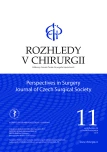Hepatic pseudolymphoma: a surprising finding in a case with suspected generalisation of lung cancer
Authors:
J. Rosendorf 1,2; H. Mírka 3; L. Boudová 4; V. Liška 1,2; V. Třeška 1
Authors‘ workplace:
Chirurgická klinika Fakultní nemocnice Plzeň a Lékařská fakulta v Plzni, Univerzita Karlova
1; Biomedicínské centrum Lékařské fakulty v Plzni, Univerzita Karlova
2; Klinika zobrazovacích metod Fakultní nemocnice Plzeň, Lékařská fakulta v Plzni, Univerzita Karlova
3; Šiklův ústav patologie Fakultní nemocnice Plzeň a Lékařská fakulta v Plzni, Univerzita Karlova
4
Published in:
Rozhl. Chir., 2019, roč. 98, č. 11, s. 469-472.
Category:
Case Report
doi:
https://doi.org/10.33699/PIS.2019.98.11.469–472
Overview
Introduction: Pseudolymphoma is a rare focal lesion which occurs in different locations. Only about 50 cases of liver pseudolymphoma have been reported so far. The diagnostic process is challenging. The lesion can resemble different malignancies using various imaging methods. No typical laboratory markers are available. The right diagnosis is usually made on the basis of histological examination.
Case report: A 67 years old female patient with lung fibrosis was undergoing assessments for a malignant-appearing focal lesion of the left lung and a focal liver lesion of unknown etiology.
Upper lobectomy of the left lung proved lung carcinoma. The liver lesion was suspected for being metastatic, therefore a liver resection followed. The biopsy revealed hepatic pseudolymphoma. It took 150 days from the first positive CT scan until the liver resection. Currently, the patient shows no signs of recurrence.
Conclusion: Hepatic pseudolymphoma is a rare disease and we have only little experience with it so far. The diagnostic process is challenging, which is clear from the presented case. Only histological and immunohistochemical examinations ruled out a malignancy. A long-term observation of the patient is indicated.
Keywords:
liver – liver surgery – pseudolymphoma – reactive lymphoid hyperplasia of the liver – liver tumours
Sources
- Usman S, Smith L, Brown N, et al. Diagnostic accuracy of magnetic resonance imaging using liver tissue specific contrast agents and contrast enhanced multi detector computed tomography: A systematic review of diagnostic test in hepatocellular carcinoma (HCC). Radiography (Lond) 2018;24:e109−e114. doi:10.1016/j.radi.2018.05.002.
- Oh J, Lee JM, Park J, et al. Hepatocellular carcinoma: Texture analysis of preoperative computed tomography images can provide markers of tumor grade and disease-free survival. Korean J Radiol. 2019;20:569−79. doi:10.3348/kjr.2018.0501.
- Dobiašová B, Zvaríková M, Petráková K. Reaktivní lymfoidní hyperplazie jater. Čas klin onkol. 2017;30:294–8. doi:10.14735/amko2017294.
- Kulow BF, Cualing H, Steele P, et al. Progression of cutaneous b-cell pseudolymphoma. J Cutan Med Surg. 2002;6:519−28.
- Grouls V. Pseudolymphoma of the liver. Zentralbl Allg Pathol. 1987;133:565−8.
- Sharifi S, Murphy M, Loda M, et al. Nodular lymphoid lesion of the liver: an immune-mediated disorder mimick-ing low-grade malignant lymphoma. Am J Surg Pathol. 1999;23:302–8.
- Katayanagi K, Terada T, Nakanuma Y, et al. A case of pseudolymphoma of the liver. Pathol Int. 1994;44:704–11.
- Lv A, Liu W, Qian HG, et al. Reactive lymphoid hyperplasia of the liver mimicking hepatocellular carcinoma: incidental finding of two cases. Int J Clin Exp Pathol. 2015;85:5863−9.
- Zhou Y, Wang X, Xu C, et al. Hepatic pseudolymphoma: imaging features on dynamic contrast-enhanced MRI and diffusion-weighted imaging, Abdom Radiol. 2018;43:2288–94. doi:10.1007/s00261-018-1468-5.
- Kwon YK, Jha RC, Etesami K, et al. Pseudolymphoma (reactive lymphoid hyperplasia) of the liver: A clinical challenge. World J Hepatol. 2015;7:2696−2702. doi:10.4254/wjh.v7.i26.2696.
- Park HS, Jang KY, Kim YK, et al. Histiocyte-rich reactive lymphoid hyperplasia of the liver: unusual morphologic features. J Korean Med Sci. 2008;23:156−60. doi:10.3346/jkms.2008.23.1.156.
- Takahashi Y, Seki H, Sekino Y. Pseudolymphoma with atrophic parenchyma of the liver: Report of a case. Internal Journal of Surgery Case Reports 2018;49:136−9. doi:10.1016/j.ijscr.2018.06.033.
- Zen Y, Fujii T, Nakanuma Y. Hepatic pseudolymphoma: a clinicopathological study of five cases and review of the literature. Mod Pathol. 2010;23:244−50. doi:10.1038/modpathol.2009.165.
- Taguchi K, Kuroda S, Kobayashi T, et al. Pseudolymphoma of the liver: a case report and literature review. Surg Case Rep. 2015;1:107. doi:10.1186/s40792-015-0110-9.
- Ota H, Isoda N, Sunada F. A case of hepatic pseudolymphoma observed without surgical intervention. Hepatology Research Hepatol Res. 2006;35:296–301.
- Moon WS, Choi HK. Reactive lymphoid hyperplasia of the liver. Clin Mol Hepatol. 2013;19:87−91. doi:10.3350/cmh.2013.19.1.87.
- Coskun M. Hepatocellular carcinoma in the cirrhotic liver: evaluation using computed tomography and magnetic resonance imaging. Exp Clin Transplant. 2017;15(Suppl 2):36−44.
- Suzumura K, Hatano E, Okada T, et al. Hepatic pseudolymphoma with fluorodeoxyglucose uptake on positron emission tomography. Case Rep Gastroenterol. 2016;10:826–35. doi:10.1159/000481936.
- Seitter S, Goodman ZD, Friedman TM. Intrahepatic reactive lymphoid hyperplasia: A case report and review of the literature. Case Rep Surg. 2018:9264251. doi:10.1155/2018/9264251.
Labels
Surgery Orthopaedics Trauma surgeryArticle was published in
Perspectives in Surgery

2019 Issue 11
Most read in this issue
- Venous access in cancer patients
- Congruence of histological diagnosis with imaging and operation diagnosis in acute appendicitis
- Laparoscopic versus open liver resections for colorectal cancer liver metastases: short term results
- Hepatic pseudolymphoma: a surprising finding in a case with suspected generalisation of lung cancer
